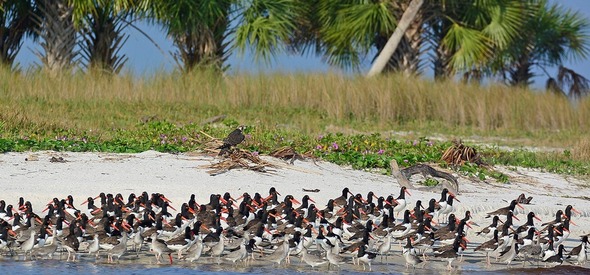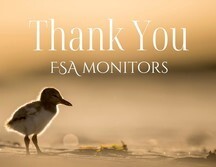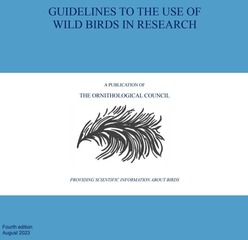Events:
November 2: Join the St. Lucie Audubon Society for a presentation of the "History of Water Management in South Florida" from 7-9 PM at the Oxbow Eco-Center presented by Kathy LaMartina of the South Florida Water Management District.
November 10-12: Florida Ornithological Society Fall Meeting
Wintering Oystercatcher Survival Linked to High-Tide Roosts

Florida’s Nature Coast is home to the second-largest concentration of wintering American oystercatchers, representing more than 8% of the range-wide population. Birds that breed in nearly all Atlantic Coast states spend their winter congregated in the southern portion of the Nature Coast near Cedar Key. This area is a paradise for wintering oystercatchers because its extensive oyster reefs provide important foraging and roosting habitats. Previous research identified that oystercatchers gather in large flocks on offshore oyster reefs during high tide. These high-tide roosts are limited in number, lack woody vegetation, are far from the mainland, are higher in elevation than the surrounding areas, and typically have low human disturbance. However, these locations are vulnerable to the effects of climate change and sea-level rise. The limited number of high-tide roosting locations in the region, coupled with current rates of erosion and prolonged high-water events, may affect the survival of wintering oystercatchers.
When optimal high-tide roost locations are unavailable, often due to the presence of people or high water, oystercatchers are forced to use more abundant but suboptimal roost locations – for example, larger islands with woody vegetation. These suboptimal roost locations can be accompanied by an increased risk of predation, causing wintering oystercatchers to expend energy avoiding predators instead of resting.
|
 The Florida Fish and Wildlife Conservation Commission set out to determine the survival and site fidelity of wintering oystercatchers and to identify factors driving survival. The analysis used 12 years of banded bird resight data collected primarily by FSA partners Pat and Doris Leary along the Nature Coast each winter. The analysis included birds banded as chicks from breeding grounds in Florida and nine other Atlantic Coast states.
The researchers concluded that adult oystercatchers who visit the study area are very likely to return every winter, showing that Cedar Key is a critically important area for wintering oystercatchers. The annual survival estimates ranged from 0.86 to 0.96; these high estimates are similar to other American oystercatcher survival analyses. However, the researchers documented a 7.3% decline in survival from 2007 to 2018. They predicted that this decline was linked to the decrease in availability of high-tide roost locations in the area. Partners conducting resight surveys documented instances of disturbance that forced roosting birds to use suboptimal locations, but there was something else that warranted attention – the duration of extreme high-water events.
 The researchers developed a strategy to evaluate the increasing risk of roost inundation during the maximum daily high tide. They looked at the number of hours during the 12-year study period when the maximum daily high tide was above a baseline normal maximum high tide level derived from a 30‐year dataset. They found an increasing trend in the number of hours that the maximum daily high tide was above normal. The year when maximum daily high tides became consistently higher than normal coincided with the beginning of a period of decline in oystercatcher survival. They concluded that birds were being forced to use suboptimal roost locations that presented more threats to survival.
The results of this study indicate that the adult oystercatchers that winter along the Nature Coast return every year. And while survival is high, the decline during the study period is an early warning of threats to this critically important wintering population. High-tide roost locations are vital for wintering oystercatcher survival, and the deleterious effects of inundation at these locations are compounded by human disturbance. Educating recreationists about the importance of not disturbing roosting birds, especially when they are at high-tide roost locations, will reduce the number of incidences of disturbance. Climate change, sea-level rise, and loss of oyster reefs are expected to continue to drive wintering oystercatcher habitat loss and high-tide roost availability, thus habitat creation and restoration are needed for this wintering population to continue to thrive. Scientists and land managers are working on ways to create and enhance habitats for wintering and breeding American oystercatchers in the Nature Coast and statewide.
The results of this research were recently published in the Journal of Wildlife Management. Florida Shorebird Alliance partners are continuing to resight banded wintering oystercatchers to contribute to the growing knowledge of movement, site fidelity, and survival. For more information, check out the following research articles or contact Shorebird@MyFWC.com.
Griffin, C. P., J. M. Brush, and A. C. Schwarzer. 2023. Decline in annual survival of American oystercatchers wintering in Florida linked to extreme high tides. Journal of Wildlife Management. https://doi.org/10.1002/jwmg.22399.
Brush, J. M., A. C. Schwarzer, and P. C. Frederick. 2017. Importance and function of foraging and roost habitat for wintering American oystercatchers. Estuaries and Coasts 40:286–295. https://link.springer.com/article/10.1007/s12237-016-0137-6.
Photos by Pat and Doris Leary.

The Florida Shorebird Database is closed for the season!
The FSD is now closed for data entry. Thank you so much to everyone who helped with collecting and entering data this season. Your hard work is essential for advancing shorebird and seabird conservation in Florida!
All data entered into the FSD are reviewed as part of the annual data review process to ensure that all data are collected and entered the same way across the state. Reviewing the data also helps clarify any unique circumstances you may have encountered over the season. This process allows the data to be used in future analyses like the abundance estimates. Be on the lookout for emails from the data review team! And thank you in advance for your patience and help reviewing the data!
Do you still have surveys that have not been entered into the FSD yet? Let us know! We can work with you to make sure all your data are included in the database. Email us at FLShorebirdDatabase@MyFWC.com.
|

The Fourth Edition of Guidelines to the Use of Wild Birds in Research is now available!
The Ornithological Council released a new edition of its publication Guidelines to the Use of Wild Birds in Research in August 2023. The fourth edition download is now available. Visit the Ornithological Council Ornithological Council website for more information.
|
|